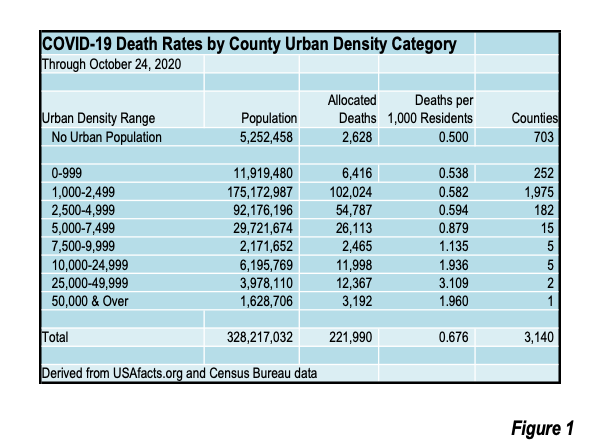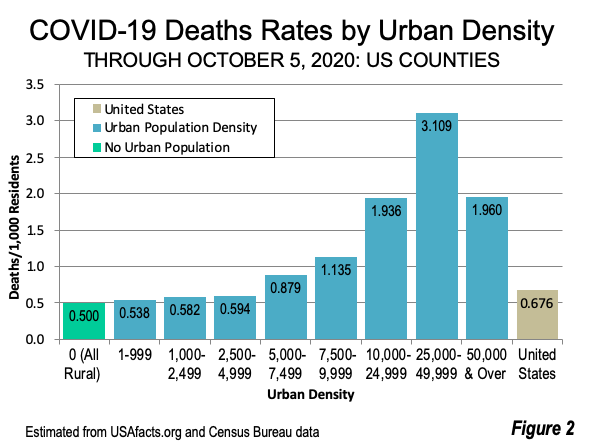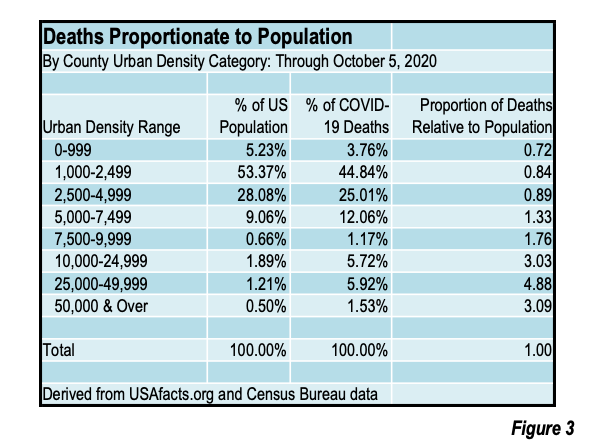There have been reports of rising Covid-19 infection rates in rural areas and even “surges,” such as here and here.
Many of these reports fail to note the most important statistic of all with respect to rural areas --- that, even with the recent increases and surges, rural Covid death rates remain below the national average. There are 703 counties in the United States that are completely rural (based on 2010 Census Bureau data), with no urban population. As of last Friday (October 24), the Covid death rate in these counties was 0.500 per 100,000 population. This is about 30% below the national rate of 0.676 per 100,000 (Figure 1 and 2). This analysis is described in “Perspective: US Covid-19 Deaths and Urban Population Density.”


All of the other counties in the nation have areas defined by the Census Bureau as urban, ranging from little under one percent to 100 percent.
Urban density is important. Covid infections and deaths are associated with higher urban densities. This is not because population density is a problem in itself. It is rather that in high urban densities it is more difficulty to avoid higher exposure densities, because the intensity and duration of risky contacts is likely to be greater. These areas are often characterized by worrying overcrowding from insufficiently ventilated enclosed spaces, such as elevators, transit, offices and public buildings. Social distancing alone is not enough. According to The New York Times: Small, crowded, enclosed spaces are petri dishes for the coronavirus. An additional problem in higher density residential areas is overcrowded apartments, often necessary because lower income households often cannot afford detached houses with yards in which kids can play. There is an important poverty connection.
The newest data continues to show that Covid fatality rates are much higher in counties with the highest urban densities. Counties with over 10,000 persons per square mile have from just under four to over six times the rural county death rate. The rural counties account for 28% fewer deaths proportionally than their population.
Counties with urban densities of less than 5,000 persons per square mile have a smaller proportion of Covid deaths than their population share. Above 5,000 persons per square mile, Covid deaths are proportionately higher than population shares (Figure 3).

Similar relationships are evident elsewhere, such as in the United Kingdom and Japan.
At the same time, however, the higher density counties have made substantial progress in controlling COVID infections and deaths. This is very good news. At least in part, this has been made possible by lockdown strategies that have led to huge decreases in transit ridership, high rise downtowns with largely empty offices and limits on elevator occupancy. The real question will be how long it will take for to return to normal, especially in the densest areas, which have been the hardest by lifestyle interruptions (see: Escape from New York).
Wendell Cox is principal of Demographia, an international public policy firm located in the St. Louis metropolitan area. He is a founding senior fellow at the Urban Reform Institute, Houston and a member of the Advisory Board of the Center for Demographics and Policy at Chapman University in Orange, California. He has served as a visiting professor at the Conservatoire National des Arts et Metiers in Paris. His principal interests are economics, poverty alleviation, demographics, urban policy and transport. He is co-author of the annual Demographia International Housing Affordability Survey and author of Demographia World Urban Areas.
Mayor Tom Bradley appointed him to three terms on the Los Angeles County Transportation Commission (1977-1985) and Speaker of the House Newt Gingrich appointed him to the Amtrak Reform Council, to complete the unexpired term of New Jersey Governor Christine Todd Whitman (1999-2002). He is author of War on the Dream: How Anti-Sprawl Policy Threatens the Quality of Life and Toward More Prosperous Cities: A Framing Essay on Urban Areas, Transport, Planning and the Dimensions of Sustainability.












